-
Posts
2,284 -
Joined
-
Last visited
-
Days Won
6
Content Type
Profiles
Forums
Blogs
Gallery
Events
Store
Posts posted by PKeating
-
-
Oh yes...
Here's a 1946 M?daille Coloniale document signed by Salan in Saigon. It's been seen here before but since we're talking Salan...
P
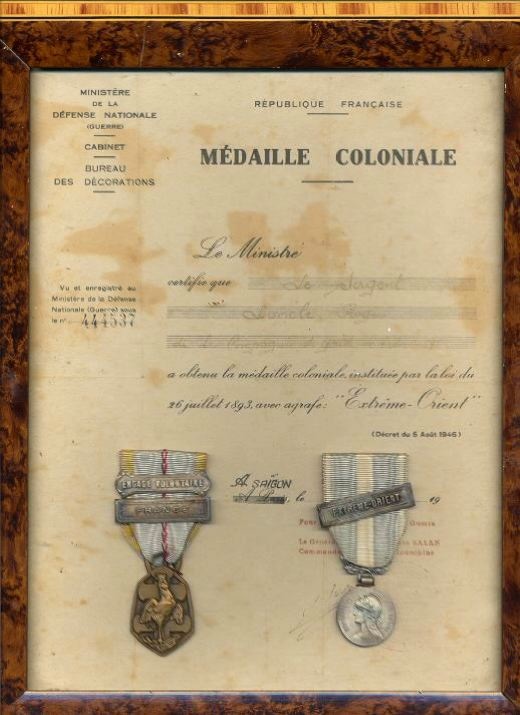 0
0 -
Quite a good Wikipedia page on the award here: http://fr.wikipedia.org/wiki/Ordre_de_la_francisque Check out some of the prominent recipients!
PK
0 -
It's an unawarded example and not worth a great deal, I am afraid. I saw a couple recently here in Paris for under ?100 apiece.
PK
0 -
I doubt it.
If the American Revolution never happened, France would not have gone bankrupt and had their revolution, so ultimately no need for a Boney to sell Louisiana. Expansion eastwards would have been severely limited.
French ambitions in North America were effectively curtailed by the British victory in 1763, ending the Seven Years or French-Indian War. These ambitions involved linking New France to Louisiana via the great rivers, with a strong of forts and settlements, in alliance with the Indian League. This would have placed a barrier in the way of British expansion across the Appalachians into the Ohio Territory and beyond. That war, described by Winston Churchill as "the first First World War", was sparked off by the murder on 28.5.1754 of a French envoy by Indian warriors and a Virginian Militia detachment under the command of a certain George Washington.
The Virginians who had invested in The Ohio Company were naturally very pleased by the victory over the French but their anticipation of lucrative westwards expansion was disappointed by London's directive that treaties banning such intrusion in Indian territories be respected. Not that this was due to any magnanimity on the part of George III and his ministers: they simply wanted to keep their subjects in the colonies on the eastern side of the mountains to facilitate the Crown's taxmen!
The American Revolution was essentially the result of the resentment that wealthy English gentlemen, landowners and businessmen, who all considered themselves thoroughly English, felt against London in the face of overcrowding due to rapid birthrates in New England and the pressing need for lebensraum and the wealth-generating opportunities denied them by London's awkward insistence upon respecting the treaties with the Indians. Taxation was one of the sparks to the powder, of course. But the root causes were not dissimilar to those of the previous war.
PK
0 -
The term "pied noir" is usually used as shorthand these days in France for Sephardic Jewish families of French-Algerian origin who fled Algeria upon Independence as opposed to French Jews of longer standing. Of course, the Pieds Noirs were gentiles too, of French and other European stock but born in Algeria, which was a French department. The "anorak" patch is interesting as there is, as far as I know, no such place as Pieds Noirs. Obviously for anoraks worn by les pieds noirs...
I love that cigarette case!
PK
0 -
Looks like a British WW1 Mercantile Marine Medal ribbon. Here's an example of the Mexican Campaign Medal with its original silk ribbon.
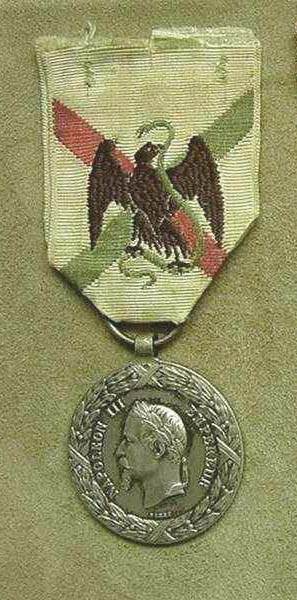 0
0 -
Very good topic so far! Thank you to both of you. As Gordon knows, there is lots of KM stuff in France so I can add that for the three bronze clasps I have seen, I have seen five silver ones...which always had me wondering. On the other hand, I have never seen any documents for the silver clasp although I have seen several docs for the bronze, plus at least nine paybooks containing the mention. I'm not a KM collector, mind you, but the subject certainly interests me enough to pay attention to KM stuff when I see it.
The Bronze Star does seem to have become a Cornflakes goodie. Mind you, as you suggest. there are still those who richly earn it! With awards, I think it was always thus, wasn't it? The CMoH was "easier" to win in the Indian Wars, for instance, just as the Victoria Cross was liberally awarded at certain times from the mid- to late-19th century. As for the MC in WW1, my grandfather was offered one because he didn't happen to have it but he politely refused. He fought at Gallipoli, on the Somme and in Mesopotamia. And yet, many MCs were hard-won.
Nothing new under the sun...
PK
0 -
In addition to not having radio equipment with them - not that the Irish Army communications equipment was up to much in the Congo anyway - Lt Gleeson's patrol was a composite sub-unit. Gleeson himself was an engineer officer and had not undergone normal officer training. The patrol was not an infantry section. Some sources say that they were based at Kamina. To get to Niemba involves a drive of somewhere in the region of 700 km. Albertville - now Kalemie - is about 80 km from Niemba and it is more likely that the patrol was out of Albertville.
Based on interviews given by Kenny and Fitzpatrick at various times, the sequence of events appears to have been as follows: The two trucks pulled to a halt a short distance from the damaged bridge. The eleven men debussed. Lt Gleeson ordered the two Brens to be left in the trucks, despite protests about this from Kenny. Lt Gleeson and Pte Kenny then approached the bridge. Apparently, the rest of the patrol just stood about in the road, rather than going into all-round defensive positions as infantrymen would have done.
On 24.11.1960, two weeks after Niemba, Irish Defence Minister K Boland responded to questions in the D?il. Amongst other things, he confirmed the following: the patrol's firepower comprised two Bren guns, four Gustaf SMGs, four rifles and (Lee-Enfield Mk4s). The medical orderly was unarmed. Mr Boland also stated that the patrol was not carrying wireless equipment. In his book Irish Army Vehicles, Karl Martin gives the following information:
4x2 VW Pick Up
Lt Kevin Gleeson: Gustav
Sgt Hugh Gaynor, Driver: Gustav
Cpl. Liam Duggan: Gustav
Pte.Matthew Farrell: Unarmed Medic
Pte Gerard Kileen: Lee-Enfield Rifle
Land Rover 88 ZIK 119
Cpl. Peter Kelly, Driver: Gustav
Tpr Thomas Fellell: Bren
Tpr Anthony Browne: Gustav
Pte. Michael McGuinn: Bren
Pte Joseph Fitzpatrick: Lee Enfield Rifle
Pte Thomas Kenny: Lee Enfield rifle
Kenny has stated that he was a Bren gunner and that he was unarmed, which was part of the basis for the award of the MMG to Browne, who was said to have defended his unarmed comrade and then drawn the Baluba away from him. However, it seems odd that Lt Gleeson would order a soldier to accompany him up to the bridge without a weapon. Perhaps Kenny had someone else's Lee-Enfield. There again, he maintains that he was unarmed and as Gleeson had already ordered the Brens left in the vehicles, he may just have been reckless or naive enough to approach the bridge with a man he had just disarmed.
So, we have a composite sub-unit of men with inadequate equipment and, moreover, inadequate training, hundreds of clicks from their home base, in a situation with clear potential to turn very nasty very quickly. In other words, some bastard sitting in a dry billet back at base has heard that the road bridge near Niemba is damaged and has sent a handy engineer officer and, it seems, any spare dick they could round up, off out into "injun country"...without a radio.
On that subject, Defence Minister Boland had this to say, and I quote the section from D?il records:
Mr. Carroll: Will steps be taken to ensure that in future the patrols will have radio facilities available to them?Mr. K. Boland Mr. K. Boland
Mr. K. Boland: A patrol such as this would not normally carry wireless equipment. It is extremely doubtful if it would have been of any avail in the circumstances prevailing on that occasion.
Mr. Lindsay Mr. Lindsay
Mr. Lindsay: Will the Minister use his good office, through prior consultation with Deputies who put down questions of this kind, to ensure that the least possible publicity will attach to them and thus save the feelings of bereaved relatives and, accordingly, allay the fears of those who have left their loved ones in the Congo?
Put another way: Can we hush this whole fecking mess up in case the voters start asking a load of awkward questions?. Politicians never change, do they? It is agreed that the fight kicked off around 15:00 hrs.
Everyone agrees that the action commenced at approximately 3 p.m. local time on 8th November. There is grim humour in Boland's remark about how useless radio equipment would have been. The standard issue 10 MHz equipment was just about up to allowing communications between the Irish Army bases but the Irish UN contingent had no direct link with Dublin. To digress, a short time before Niemba, an Irish engineer in Uganda, Terry Tierney, happened to be a radio ham and kept in touch with a friend, Father Jim Stone, in Dublin via their 28 MHz radio sets.
As the story goes, Tierney was dialing around the 7 MHz frequency one day and heard Captain Brendan Deegan using the Charlie Quebec callsign of the Curragh Camp Army Radio Club. Capt Deegan was based in Goma, one of the Irish main bases in the Congo. As a result, Deegan was able to give the lads fresh news from home. Tierney then built Deegan a 28 MHz transmitter.
Arranging an RV on the border, the two men met and Tierney gave Deegan and his escort the transmitter and a suitably powerful receiver. It should be pointed that that the drive to the RV took Tierney twelve hours and that much of it was through dangerous territory because of the armed bands operating without regard for the border between Uganda and Congo, much like the situation persisting today. In return, Tierney was given some biscuits, packets of tea and a couple of jerry cans of petrol.
Now, in case you're all anticipating an account of how Capt Deegan was able to establish comms with Dublin, thanks to the courageous Tierney (who should have gotten a medal as well), don't hold your breath. Deegan drove back to Goma and established comms with...Fr Jim Stone. The Chief of Staff of the Irish Army, General Se?n McKeon, finally heard of the link to Goma and was duly invited by Fr Stone to visit his home beside the parish church in Killester, Dublin to address the troops in the Congo. By chance, General McKeon's visit was on 9.11.1960. Some sources say it was the previous day. As he communicated with the CO of 32 Bn, Colonel Buckley, in Goma, General McKeon was informed of the trouble at Niemba. Not long afterwards, Army HQ in Dublin set up a telex link to their forces in the Congo. The Dubliners amongst you can see Fr Stone's radio in the Howth Martello tower.
Coming back to Niemba and the chronology of events based on an evaluation of the various accounts from the survivors, the Baluba apparently overran the two vehicles as they approached the patrol, depriving the patrol of any chance to retrieve the Brens. This therefore casts doubt on the Baluba assertion that a Bren was deployed against them. Lt Gleeson walked up to the Baluba and was attacked. The 2IC, Sgt Gaynor, trying to come to the Lieutenant's aid, was also attacked. The remaining nine men were now leaderless and three of them were unarmed. They stood no chance at all. The only thing that saved Browne, Kenny and Fitzpatrick was the Baluba's own lack of field discipline, enabling the three men to escape. It is revealing that "gendarmes" on their home turf, who tried to present themselves as a legitimate defence force of sorts, did not send pickets to flank the intruders, as they saw them, before launching their attack.
The Irish soldiers at Niemba and in other places in the Congo were let down, as soldiers through the ages so often have been let down. Some might see the radio story as quaint and charming but as an ex-soldier myself, I see it as grotesque. Ireland was not short of experienced combat veterans. She never has been! They may not have served under the Tricolour when gaining their experience but many of them would later serve in the Irish Army after WW1 and WW2 as Senior NCOs. Some of them were officers but few of the officer corps of the 1950s and 1960s had ever been in combat of any kind and it showed during those early years of Irish participation in UN operations. They obtained their ranks and advancement on the golf links of Wicklow and Kildare and in the gentlemen's clubs of Dublin. If the Irish Army has managed to acquit itself well since the Congo, it is due to the backbone provided by tough NCOs from tough districts in Dublin and Cork, who grew up, to paraphrase Se?n Tracey, with a smell of broken glass in their noses...
It would probably make quite a good film. It would be a much better film than The Wild Geese and that whole genre of mercenary sub-dramas of the 1960s and 1970s. I met "Mad Mike" Hoare, who was a buffoonish ex-Pay Corps REMF and Bob Denard, who was much more serious, as one might expect of someone so obviously employed by the Belgians as a "black ops" or "wet ops" troubleshooter. I also know the only Englishman known to have been taken prisoner by the Irish Army. He lives here in France now but I have known him for thirty years. He has always said that the Irish soldier on the ground is second-to-none and that's high praise from a former 2 Para officer and veteran of Katanga's mercenary levies, a public school Englishman of a certain age and background who might normally be inclined to sneer at the Irish in general.
PK
0 -
Dear Mr Ryan,
Thank you very much for posting this article. I hadn't seen it. Declan Power summarises the situation and the events very clearly, although most of the informed commentaries on Niemba refer to a bridge that had been damaged, rather than a roadblock per se.
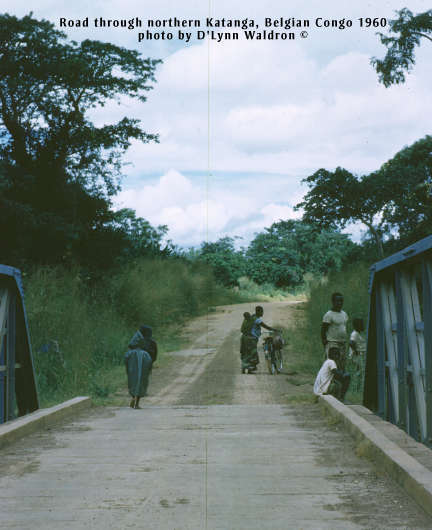
Copyright ? D'Lynn Waldron
I haven't seen the bridge near Niemba but this photo, taken in 1960 by the author and photographer D'Lynn Waldron, shows a fairly typical road and road bridge of the time. Such road bridges are fairly easy to render impassable but can just as easily be repaired. I intend to try to interview Messrs Kenny and Fitzpatrick the next time I am in Dublin. I suppose the truth of Niemba may lie somewhere between the accounts rendered by both sides. There are statements in the report published by Commandant Mambwe that are hard to believe but then, can any account composed of various eye witness reports be completely accurate?
There is a certain element of bathos in Mambwe's description of the Balubas' alleged initial contact with the Irish UN truck. If it is true or partly true, one can only imagine the reaction of a load of boys from poor areas of Dublin and a couple of country lads when confronted by terrifying "savages" in leopard headdress, straight out of old soldiers' tales from the 19th century, armed with all sorts of nasty-looking weapons, like the ones below.
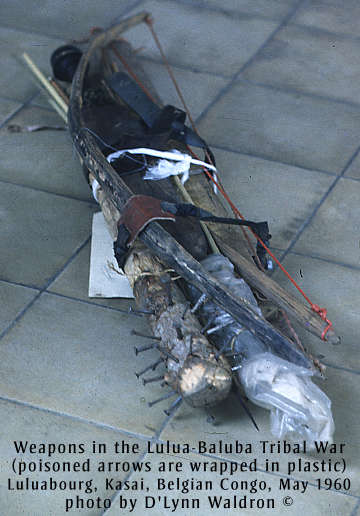
Copyright ? D'Lynn Waldron
When I was a kid in Dublin in the 1960s, black faces were very rare; the only black people one saw were Trinity and UCD students, diplomats and the occasional merchant seaman. Ireland was whiter than Daz. If one of them did loose off a shot - and one of the survivors is recorded as having 'thought' that he heard a shot before the hail of arrows - it would certainly be understandable, even if it could not be condoned.
It is more likely to have been the case that the Baluba crept up on the patrol and jumped them. Although the prison terms handed down to the Baluba snatched from a local hospital afterwards by Irish forces were considered light by the Irish, they nonetheless averaged five years, which is no joke in that part of the world. In other words, the Congolese authorities seem to have tacitly admitted that fault lay with the Baluba. Interestingly, the Irish Army report on the hospital snatch remains off-limits to the public.
Here is the text of the interview Joe Fitzpatrick gave from his hospital bed after the incident. Tom Kenny was in an adjacent bed.
On 8th November 1960 a Platoon of Irish UN Troops set out on what should have been a normal Patrol, nine of them died at the hands of the Balubas. Two of the Platoon survived to tell the story of the ambush. They were Trooper Thomas Kenny and Private Joe Fitzpatrick.I think I could give no more graphic description of the ambush than to quote in full, the interview which Private Fitzpatrick give when in hospital in Albertville. In the same ward in the bed beside Fitzpatrick lay the other survivor Thomas Kenny.
"We were on a routine patrol. It was normal to go down the road leading south from Niemba and find a roadblock that had to be cleared.
Balubas were always doing this and we used to curse them almost good-naturedly while, in the hot sun, pulling down their handiwork - usually heavy logs piled across the road.
But this time they had done a more thorough job. They had pulled to pieces a wooden bridge across a small river, and it was taking us a lot more time than usual to put it right.
We had noticed lately that the parties of Baluba we met were getting more sullen and hostile. We never had more trouble than an odd arrow shot our way and we had always managed to bring about a peaceful end to our meetings with them.
So we were not at all expecting what happened this time. There we were, working away at that bridge with our Platoon Commander, Lt. Kevin Gleeson, and Sergt. Gaynor supervising, when someone called out there were Balubas coming down the road behind us. I looked up and there were about a hundred of them carrying bows and arrows, spears, panga knives and clubs.
Lt.Gleeson told us to stop working and be on alert with our weapons. Even then we did not expect trouble. We thought it would be another parley and then they would go away.
Lt. Gleeson walked towards them alone, holding up his right arm in sign of peace. They called out "Jambo" which is an African word meaning "I greet you in peace"
I looked away for just a moment for some reason or other and heard a shout from the lads. Then I saw Lt.Gleeson staggering with an arrow in his shoulder. I heard him yell, "Take cover, lads get behind the trees.
We did just that and withdrew into the trees on each side of the road. Most of the boys took cover on the opposite side of the road that I did - that is really how my life was saved, because the major Baluba attack went that way.
The air was suddenly black with a shower of arrows, and the Buluba let out blood-curdling yells that sounded like a war cry and rushed down the road like madmen, jumping in the air and waving their weapons.
I don't know who give the order to shoot, but we seemed suddenly all to be shooting.
I saw Lt. Gleeson killed. He didn't really get off the road. He fired into the Baluba with his sub-machine gun, covering us, looking quickly back over his shoulder to make sure we had taken cover. Then he turned and ran for the trees himself.
But they overtook him and ran him down. Some had outflanked him and cut off his attempt to get to cover. A lot of them reached him at the same time and they were howling like animals. Our Officer went down under a hail of blows from knives and clubs.
I don't know what I was thinking at the time but I have plenty of time to think since and that sight was the most awful memory of it all. Lt. Gleeson was a wonderful man and we loved him- we all loved him.
From that moment it all became very confused. The fight spread out among the trees. I could not see most of it. But there was a terrible noise, shouts, shooting and screaming.
The Baluba seemed to be everywhere, crushing through the bushes and giving their sort of high pitched battle-cry.
I heard our lads yelling, too. I heard one of them swearing. I remember I recognised his voice and I called out his name.
I heard another Irish voice say! Oh my God! and it ended in a sort of sob.
I saw about 12 Baluba in a hand-to-hand fight with one of our lads, who was using his rifle like a club. I feared to shoot for hitting him. Then I realised he was going to be killed anyway if I did not shoot and I fired two long bursts and saw three Buluba fall.
The rest of the Baluba ran away and I went to the lad who was my friend. He was still alive but could not answer when I spoke to him. He had three arrows in his body and was terribly cut with knives or spear wounds.
I tried gently to pull the arrows out of him but they would not come away because they were barbed. I stayed with him till he died ten minutes later.
I could still hear the Baluba about me but there was no more shooting.
I started to move through the bush, knowing that if they found me they would kill me.
Suddenly there was a crashing to my right. I threw myself on the ground, rolled under a bush so that I was covered.
I heard Baluba voices almost right above me- I think they were so close I could have touched the speakers.
For one terrible moment I waited for the spear-thrust I felt sure must come. But then they moved away. They had not seen me.
I lay there without moving for three hours till it became dark. Ants and other insects crawled over me.
After it was dark I got up and moved towards the road but in such a way that I would miss the scene of the fight. I found the road and moved along it, keeping close to the trees. I felt ice cold and my teeth were chattering although I knew the night was sticky and warm. I wondered if I had malaria or fever, or something.
I walked cautiously with my gun at the ready. The night was pitch black and I could just see the pale blur of the road. I began to tremble violently.
I was jumping at every sound. I began to feel that I was being watched and followed. I stepped on a dry twig, which snapped, and my heart jumped at the sound. Suddenly I heard a distant singing. I came to a native village at the roadside where there was singing and shouting and I saw fires burning. They sounded terribly drunk. I felt certain that it was the people who had attacked us.
For a moment I had a wild impulse to creep up on them and let them have it with every bullet left in my gun. Instead I moved back into the jungle on the opposite side of the road. I was getting terribly exhausted and several times fell over roots and things and collided with tree branches in the dark.
I could hear frightening sounds and rustlings of animals about me, but I was past caring. I stumbled and put my hand on the branch of a tree to steady myself and yelled out aloud in pain and fright. The branch seemed alive with crawling insects. Something had stung my hand.
I staggered a few more yards and sank to the ground. I felt dazed and my thoughts began to wander. I thought of my mother, and the coolness of Ireland, of the rain in the streets of Dublin and how peaceful it was there.
I wished so much that I could get out of this God-forsaken country of filth, sweat and heat and savages. I think I prayed it might be so. I think I dozed or fell into a stupor or something then because suddenly it was getting light.
Pulling myself to my feet I wandered slowly through the jungle again. Suddenly I heard the sound of a truck and heard Irish voices. I shouted and ran towards the lovely sound of it. I fell but got up and kept on going and came out on the road. It was a truck full of some of the boys from Albertville.
I fell into their arms.
PK
0 -
There is no such thing as the perfect fake. And anyone who cannot tell the difference between old, traditional hand or machine engraving and laser engraving ought to think about learning how to do so.
PK
0 -
Coming back to Niemba, the debates continue in the D?il:
2005: http://historical-debates.oireachtas.ie/D/...0511030014.html
2006: http://historical-debates.oireachtas.ie/D/...0611160017.html
In the second record from a Dublin parliament session in 2006, Defence Minister Willie O'Dea stated:
The second area of controversy in regard to the record of the Niemba ambush is what did Trooper Browne do to contribute to the survival of Private Kenny. The report clearly concludes that prior to his escape from the ambush site, Trooper Browne fired his weapon at the Balubas who were intent on beating Private Kenny to death, thereby distracting them and saving his life. The Medal Board that was convened in 1961 awarded Trooper Browne the military medal for gallantry.Despite all the research, consultation and interviews, there is no absolute certainty achievable in regard to these two matters of controversy. I wish, however, to address some of the ambiguity that may have resulted from the two scenarios recorded in the unit history. In the absence of the wide and detailed research available to me now, the best advice previously available to me was that Trooper Browne most likely died at the scene of the ambush and the Baluba tribesmen carried his remains away. This must now be discounted.
I wholeheartedly recognise and acknowledge that Private Kenny, particularly in view of the serious wounds and injuries he sustained, and Private Fitzpatrick survived a horrific encounter with hostile forces, displaying courage, fortitude and tenacity in order to survive until finally rescued. I commend them both for the selfless service they gave to their country and hope that this report will bring some peace of mind to them both.
So the truth is finally albeit gradually emerging, dragged from the Irish authorities as if it were blood from stones. It might, of course, have been more convenient for the Irish establishment had Kenny and Fitzpatrick also died. As for MMGs or DCMs for Kenny and Fitzpatrick, the Minister offers them "peace of mind" as a reward not just for displaying "the courage, fortitude and tenacity" of their dead comrades, who all received posthumous medals in 1998, but surviving.
O'Dea continued:
Now that we have fuller information, I am required to officially correct the record and I have no difficulty with doing so. I also have no difficulty with making an apology to the two men if the original record at my Department got the facts wrong. I apologise for any trauma or grief caused by the fact that the record was incorrect.It is not within my power to grant a medal. That is a matter for the Army, which decides on who is awarded medals. In this case it recommended not to do so, which is no reflection on either of the gentlemen in question. Detailed considerations are involved. After two military boards, the Army has not recommended medals. I cannot tell the Army when to award a medal.
The report has just come into the public domain and the type of recognition to be given is still under discussion. I hope we will find a way to adequately recognise the courage and fortitude of these two men.
Mr O'Dea seemed to be saying that the Irish Defence Forces were not subordinate to his ministry. Great! Roll on military rule in Ireland! The ghost of Eoin O'Duffy must be smiling. Well, if the Irish Army were subordinate to the government elected by the Irish People, Mr O'Dea and his colleagues might be able to advise the military board to recommend awards to the two survivors of Niemba, given that it is abundantly clear that they were not only as brave as their comrades but managed to survive in very hostile country until they were rescued.
On top of that, Kenny was unarmed as a result of the order to leave his Bren in the truck. Browne may well have saved Kenny by drawing his attackers away, in which case he might have deserved the MMG 1st Class, had he been killed doing so or not. Kenny contends that Browne did not save him. Kenny was probably delirious when he was found after the fight so anything he may or may not have said then might not be reliable but in the light of his more recent statements, it seems as if the Irish Army wanted a hero and Browne was the man, Ireland having always placed a higher premium on dead rather than living heroes.
According to the Baluba "gendarmes", the Irish were firing with at least one Bren. It is possible that the other Bren gunner managed to retrieve his weapon from the truck. After all, if the Baluba version is to be given any credence, the Irish managed to hold hordes of fearless tribesmen off for two hours. Two hours is a long time. A lot of ammunition would be required for a section to maintain the high rates of fire suggested by the Baluba's own account of the engagement and the recollections of Kenny and Fitzpatrick. The initial firefight may have taken a few moments, whilst the butchering of the dead and wounded Irishmen and the decoration of trees with their body parts and innards may have lasted until 17:00 hrs, before the victors retired to celebrate around their fires.
However, if we are to be politically correct and to place as much faith in an enemy action report - although the UN cannot refer to hostile combattants as "the enemy" - in this case as we would place in, say, a German report on which Allied bravery decorations were based in the Second World War, we would be obliged to conclude that Ptes Kenny, Fitzpatrick and Browne were the last men standing at the end of a two-hour defensive battle and that they then escaped and evaded enemy forces for several days afterwards, trying to make it back to their lines, we would have to concede that Kenny and Fitzpatrick deserved to be decorated as much as their less-fortunate comrade Browne.
There are quite a few people in Ireland who share this viewpoint, hence the regular pressing of the question by various TDs in the D?il. The Irish establishment awarded the Military Star (An R?alt Mileata) to the NoK of the Niemba KIA at Collins Barracks in June 1998, this being an exclusively posthumous decoration for members of the Irish armed forces who have been killed in the line of duty. Other MS were awarded that day. So the MS cannot be awarded to Kenny and Fitzpatrick.
One is always wary of devaluing military awards by allowing politicians to hand them out decades after an event as if they were candy but this does seem to be a case in which the Irish establishment has behaved shabbily, from causing those men to be out there so badly equipped in the first place to all the prevarication and obfuscation of the intervening years. In view of the revelations following the award of the MMG 2nd Class to Browne, who, as we have concluded here, probably earned it even if the wrong reasons were cited, his fellow survivors should certainly receive the MMG as well. Ideally, they ought to receive the MMG 2nd Class.
Something fairly similar to the Niemba fiasco happened to some French paratroopers in Afghanistan this year. Those men were let down badly. The difference is that President Sarkozy had the character to fly out there and assume responsibility. It is time for Ireland to assume responsibility for Niemba and to put things right by apologising publicly to the survivors and to the next-of-kin of the dead and by decorating the survivors, thereby giving them something tangible that they can wear on their lapels to show that their country really does care...
A parade in front of Collins Barracks in Dublin, even if it is a museum now, with Tom Kenny and Joe Fitzpatrick receiving the MMG from the President of Ireland would be a fine thing to see. It would be a graceful gesture by an Ireland that paid so much lip service to the question of protecting the country's neutrality during the lead-up to the recent Lisbon Treaty referendum. Perhaps they will rectify all this for the 50th Anniversary of Niemba in 2010. Or they could just do the decent thing and call Kenny and Fitzpatrick up in front of the nation sooner rather than later.
And pigs might fly...
0 -
To say that it is a pleasure would be a clumsy use of words but you know what I mean, Paul. It was a terrible incident and all the worse because Gleeson's patrol was simply doing what the UN forces were supposed to do in terms of maintaining open lines of communication. Whoever sent a ten-man patrol and a young officer to repair a bridge known to be a hot point between the two factions the UN were trying to keep apart ought to have been cashiered.
I shan't bore you with an explanation of how the area around the bridge should have been secured to at least a reasonable minimum but anyone with even the most basic military training in field tactics and field craft would agree that near-criminal recklessness was one of the contributing factors to Niemba. From the young subaltern who ordered the Brens to be left in the truck - unattended! - against SOPs, despite being told, apparently, by Pte Kenny that it was ill-advised and against orders, to the idiots who ordered them out there to fix the bridge, heads should have rolled.
Ah well, poor Gleeson did pay a heavy price and one oughtn't to speak ill of the dead and all that, but considering that they took out at least twenty-five attackers with the weapons they had, they might have fared better had Kenny and the other Bren gunner been covering the operation from fire positions instead of deployed as unarmed manual labourers. It is hard to say because they were heavily outnumbered.
The action of the Baluba in drafting a statement the following day proves that, savage through they were in battle, these were not simple, ignorant tribesmen. They were not "savages", as they were described in various quarters. They were gendarmes. They were, for their intents and purposes, members of a bona fide paramilitary unit with a brief to defend their territory and their people from hostile incursions.
They were brutal because Belgian rule had brutalised them, a legacy that persists to this day in the region. Paradoxically, it had been an Irishman, Sir Roger Casement, who brought Belgian bestiality in the Congo to the World's attention before the First World War, an exposure that led to slightly better behaviour on the part of the Belgians and, ultimately, independence in 1960.
Some elements amongst the local Baluba certainly realised that they had erred in slaughtering the Irish UN soldiers, hence the statement and, perhaps, the murder of Browne, whom they probably viewed as a witness who might identify perpetrators. Or perhaps they just liked killing white people. This would be understandable, given their history with the Belgians. Here is the other side's view of the Niemba incident, in the form of a report by Commandant Louis Mambwe of the Kiambi Gendarmerie. The report was drafted on 9.11.1960 and released as a statement on 15.11.1960.
Territory of ManonoKiambi Post
Kiambi, 15 November 1960
Re:Kasanga chieftainship?s war against the UN.
I,the undersigned, Louis Mambwe, Commandant of the Kiambi gendarmes, present the following report:
When we left Kiambi on 9 November 1960,Chief Kasanga and his president, Andr? Ngoie, told us that they had fought that battle the day before?that is to say, on 8 November.
This is how it happened:
1 We were told that those against whom we had fought were UN people. That is not possible. If they had been UN personnel, they would not have been patrolling with some of our enemies among them. This is the third time they have come to our area, because we don?t have a war here. We only want to fight the Kiambi people; those are the ones whom we seek. We have learned that they are real men and that?s why we want to fight them.
2 Those Europeans from the Niemba post,came here for the third time. What was their motive? It?s 35 km from Niemba to Kasanga, and at the 25-km mark there runs a small river called the Lweyeye; we destroyed the bridge spanning it because we feared our enemies would come that way to enter our territory. We are all members of the coalition here, as are the Kiambi people. Although the Europeans constantly repaired the bridge,we demolished their work each time. They asked us if the Kiambi people had come to demolish their work on the bridge and we replied, ?Yes?. Then they told us they wanted to fight against the Kiambi people. The first time they said that, they went back because it was impossible to advance.
3 Another day, they came to repair the bridge again and said they were from the UN. We let them do it but we thought that if they were from the UN, they could not fight against the coalition. They returned to Niemba saying they?d come back in three days.
4 Then we asked ourselves how we would know if they were from the UN or were our enemies, the next time they?d arrive at our barrier.
5 Our commander?an ex-sergeant major, first class?said we should dress in our coalition clothing, including leopard-skin headdress, as if preparing for combat. The UN people had already seen coalition warriors dressed like this. If they were really UN people, they would not do anything.
6 When it was time for them to go to Kiambi, our commander called his gendarmes to enact the battle. He positioned his advance guard at the barrier to our territory. Then he told us that when these men came, he would approach them dressed as a member of the coalition. If, at that moment,they fired their rifles, it would mean they weren?t UN personnel but our enemies. Ngoie is the president of the Kasanga Senate, imposed by the Niemba administration to the aforementioned chief.
7 In fact,when they arrived on the other side of the Lweyeye, our commander approached them. He put a leopard-skin on his head, in the manner of the coalition [forces] and left with four gendarmes.
8 The commander went in front of their truck, with his gendarmes, and pointed to the leopard-skin on his head. All of a sudden, without warning, he was struck by bullets, as were the four gendarmes. The commander fell dead on the spot.
9 Seeing that their commander had been shot dead,along with the four others who had followed him, the remaining gendarmes, who were armed, unleashed a hail of arrows.
10 When these enemies saw the coalition forces firing arrows, they increased the firing rate of their own weapons, which included a machinegun and a Bren gun. Having seen this,the coalition forces understood that these people did not intend to flee and were behaving like enemies. They [the coalition forces] continued to fire their arrows.
11 In truth, many enemy and coalition personnel died there. The battle began at 3 o?clock and finished at 5 o?clock. Bodies were scattered everywhere.
12 Now, we are accused of having waged war against the UN, whereas it was they who were at fault: (a) it was they who started shooting; (b) they fired non-stop for two hours, until the end of the battle?why?; ? we saw no difference between the UN and our enemies because they didn?t stop firing.
13 If they were from the UN, they would have stopped firing for a second or a minute, and the battle would not have continued. In any case, there would not have been so many gendarmes killed.
Kasanga, 9 November 1960
Commandant Louis Mambwe
0 -
What a rare thing indeed! Until 1984, the MMG was awarded in three classes, 1st, 2nd and 3rd, the grade denoted by the pattern of the riband. The grades have, I believe, since been described as the Military Medal for Gallantry with Honour, or so-called 1st Class grade, followed by the "with Distinction" and "with Merit" grades. When it was instituted in 1944, Ireland was a neutral state in the style of Sweden or Switzerland and the award was for members of the Defence Forces for exceptional valour in non-combat situations. They clearly couldn't have foreseen United Nations-related situations involving extreme combat, like the Niemba Ambush on 8.11.1960, for which Anto Browne received a posthumous MMG 2nd Class.
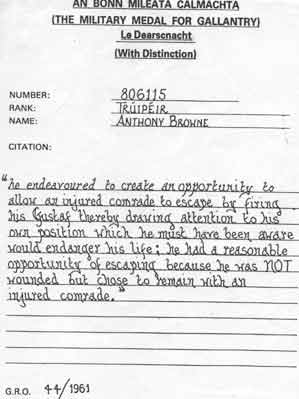
http://homepage.tinet.ie/~benhalligan/mmg.htm
He endeavoured to create an opportunity to allow an injured comrade to escape by firing his Gustaf thereby drawing attention to his own position which he must have been aware would endanger his life. He had a reasonable opportunity to escape because he was not wounded but chose to remain with an injured comrade.The text of the citation suggests that Browne died at the scene of the ambush. However, this does not seem to have been the case. The patrol?s mission was the repair of a river crossing near the village of Niemba, damaged by local Baluba tribesmen aiming to hinder raids into their territory by Katangan secessionist troops. These local Baluba were loyal to the government installed in L?opoldville the previous June, following independence from Belgium.
The UN forces were there to try to maintain order. This brief justified the dispatch of Lt Gleeson and his ten-man patrol to repair the bridge in question. For their part, the local Baluba must have seen this as not just an unacceptable interference in their affairs but an action that seemed to favour the interests of their enemies.
Niemba was a cock-up. The patrol had no working radio equipment and were wearing home-issue kit, totally unsuitable for conditions in the Congo. Even though the Irishmen killed at least twenty-five of their attackers, the fact remains that it was a terrible defeat, compounded by the fact that Lt Gleeson had ordered the patrol?s two Bren gunners, including Kenny, to leave their weapons in the truck when they bebussed, so they were unarmed, despite their protests. Three of the men, including Browne, were armed with Gustav submachine guns. The rest had Lee-Enfield Mk4s. Some Irish Congo veterans feel that Gleeson might have been court-martialled had he survived.
Gleeson and his men came under a hail of arrows, some of which had been dipped in Black Mamba venom. In the ensuing battle, eight of the Irish soldiers were killed, either outright or beaten and hacked to death as they lay wounded or dying from the snake venom. Three Irish soldiers escaped: Ptes Kenny, Fitzpatrick and?Browne. Kenny and Fitzpatrick were found alive by search parties in the following days but Browne was listed as missing, presumed dead.
Of the eleven man patrol, just two survived: Ptes Thomas Kenny and Joe Fitzpatrick. Lt Kevin Gleeson, Sgt Hugh Gaynor, Cpls Peter Kelly and Liam Dougan and Ptes Matthew Farrell, Thomas Fennel, Gerard Killeen, Michael McGuinn and Anthony Browne were killed.
When the badly wounded Kenny was found early in the morning of 10.11.1960, he identified himself and was said to have described Browne as the only member of the patrol who did not panic. Kenny allegedly stated that attacking Baluba warriors were attracted to Browne because of the sound of his Gustav submachine gun and that Browne then drew the Baluba away from the wounded Kenny, who subsequently lost sight of him. Kenny had been pierced by four arrows, one of which fractured his skull. Kenny also reportedly described Browne as dragging him into cover before running in the opposite direction, chased by ten or more Baluba.
Given the heroism of Anthony Browne, as publicised by the Irish authorities at the time, it does indeed seem odd that Browne did not receive the highest grade of the Military Medal for Gallantry, as illustrated in this thread. As the citation stated: "He had a reasonable opportunity of escaping because he was not wounded but chose to remain with an injured comrade". Browne?s parents were duly presented with their son?s MMG 2nd Class in September 1961.
However, about a year later, an Irish Army officer stationed in the Katangan capital Elizabethville learned from a Belgian official that the whereabouts of Browne?s remains were known. These were recovered by the Irish Army on 7.11.1962 and a four-page report was filed, following enquiries in the area. As a result of the report, 33 Bn?s unit history was amended by the addition of an appendix to the account of the Niemba action, which stated:
Information which we had received from Baluba survivors [of the 8 November 1960 incident at Niemba] in Manono hospital led us to believe that he [browne] had been killed immediately after saving Private Kenny, and that his body had been removed from the scene by the ambushers?. The amendment further stated: :?Apparently some days after the ambush,wounded,exhausted and starving he [browne] had called some women at the outskirts of the village [of Tundulu] and asked them for food and directions to the railway line, offering them 200 francs. They took his money but instead of helping him they told the young men of the village who came out and killed him.?The late Brigadier-General P D Hogan, commanding the Niemba search and recovery operations in November 1960, had this to say in an interview shortly before his death in 2004:
It was a sad business. Sadder was the fact that Browne was alive?a fact which hasn?t added to the gaiety of my life since,I can tell you. He travelled some miles through the bush, as Kenny did, but he didn?t come out onto the road as Kenny did. Kenny was lucky to find the road. There was no road right or left of it for twenty miles. He was bloody lucky. But poor Browne didn?t find the road. If he did we would have picked him up. He went back towards Niemba?whether that was by design or by accident?through the bush. Some days later on he was lying outside a village and some young women came out collecting firewood. By signs,he offered them money for food. They went back to the village but instead of bringing out food they brought out young men who beat him to death. We found his skeleton two or three years later on. I have a photograph of it, indeed. His remains were brought home and buried with full military honours in Dublin.The Irish Army managed to arrest some of the Baluba involved in the ambush, who received fairly light prison terms. The army report on this operation, comprising a raid on the hospital where the Baluba wounded were being treated, remains unpublished. Before the Niemba incident, the Irish UN soldiers in the region had been on reasonably friendly terms with the Baluba although Kenny is further quoted as saying that the ambush happened because army staff ignored warning signs of unrest amongst the local Baluba following incidents such as the wounding of a local chief?s son by an Irish soldier. For their part, the Baluba have always maintained, since the publication of their own report, written on 9.11.1960, less than twenty-four hours later, that the Irish opened fire first.
This was rather embarrassing, of course, so the Irish Army decided to stick to the official version of events. However, in 2000, Thomas Kenny made some rather controversial statements. which were reported in The Irish Independent, amongst other newspapers:
http://www.independent.ie/national-news/co...ory-516794.html
Kenny said: "I am not trying to denigrate the bravery of Anto Browne during that attack when it was every man for himself, I saw him firing and fighting with the best of them. But everyone believes he died to save me and that is not the truth. It is a terrible burden for everyone to think that the reason I am alive is because someone gave up his life to save me. It just isn't true and I want what really happened to become public knowledge rather than just among the Army, who have never came out and said what really happened".
If Kenny's statements are true and he did indeed make a frank report to his superiors upon his return from the Congo, then this might explain why Anthony Browne did not receive the highest grade of the Military Medal for Gallantry at the time. There may have been dissension resulting in a compromise of sorts. It certainly seems to be the case that Browne did not lay down his life for his comrades, as the official version of events and the citation state, because he survived the action and was killed several days afterwards. The eight other men killed in the action received posthumous awards in 1998 as part of a general issue of retrospective and posthumous awards.
However, awards for Niemba had previously been proposed in D?il ?ireann at various times; in 1987, Defence Minister Noonan had parried with a vague undertaking to consider the possibility of a memorial to the fallen of Niemba. This, at least, was better than his predecessor?s reponse in 1985 to the proposals of MMGs or DSMs for the Niemba fallen: ?The best memorial to those men is the certain knowlege to their families that the men are remembered with pride and affection by the Irish people?.
Neither Tom Kenny nor Joe Fitzpatrick received any awards. Perhaps Thomas Kenny had a black mark on his record for trying to set the record straight with the report he made to his superiors when he got back from the Congo. Perhaps the Irish Army feels that surviving was sufficient recompense for Kenny and Fitzpatrick. However, the lasting image for me in relation to this terrible affair, however, is that of poor Anto Browne dying alone out there. I suppose his parents eventually learned the truth, which must have been pretty grim for them. If their son's MMG brought them some comfort, then who would begrudge them that? He probably earned it, even if the citation gets it wrong.
PK
0 -
Rare material indeed! I had seen French-made miniatures like the MM but had no idea that French firms produced full versions of these awards. The relative size of French and British miniatures frequently poses an aesthetic problem for veterans whose medals can be mounted together. I believe that some French awards and more common campaign and war medals were manufactured in miniature by British firms like Firmin just after WW2. I had this problem a couple of years ago when obtaining French miniatures for Peter Churchill, who served with N? 4 Commando's Free French contingent in 1944 and 1945. In the end, I think Peter mounted them as shown here and wore them under his British miniature group but it would have looked better, of course, to have them mounted in proper order of precedence, all together as they would be on his full size rack.
PK
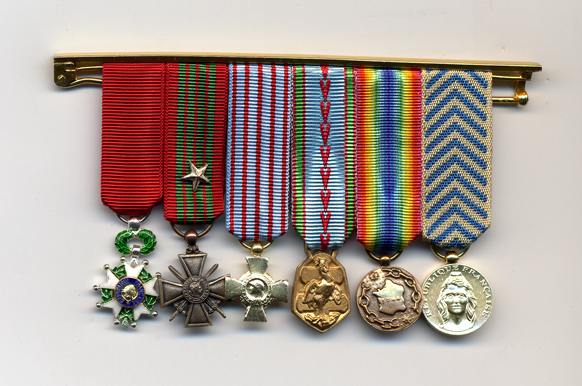 0
0 -
Hi,
Airborne units in North Africa in World War 2? More likely during the Algerian uprising in the 50s.
Well, what about the Troupes Coloniales?
Regards,
Mike
French airborne soldiers on operations in North Africa certainly received the Colonial Medal. I have seen medal grous with the clasps for "Libye" and "Tunisie" on Colonial Medals, along with the paperwork, to members of 1?re Compagnie d?infanterie de l?Air, which was attached to the SAS and known as the French Squadron. One of these men had "Libye", "Tunisie" and, as a veteran of Indo-China in the late 1940s and early 1950s, also had the "Extr?me-Orient" clasp.
1 RPIMa was garrisoned in Beirut and Damascus in 1941, then at Kabret, on the Suez Canal in 1942. Members of the regiment were engaged on operations in Libya in 1942, attacking Axis airfields. The regiment was also deployed behind German lines in Tunisia in 1943. 1 RCP was on standby in Algiers during the summer of 1940 but not engaged in operations. the unit was garrisoned in Algeria in 1941 and Morocco in 1942 and 1943. Members of those units received Colonial Medals with the appropriate clasps.
As Ed Haynes says, the medals are unnamed. We are really talking about documents or, better yet, medals and groups with documents and other supporting paperwork and documents are hard to come by. The problem is that families either file them forever, which is fine, or throw them out when grandpa dies, and then sell the medals and badges for a pittance. They don't even imagine that the documents might be of interest to collectors.
PK
0 -
Very nice armbands! The Croix de Feu was considered by some to be a far-right organisation, and possibly even fascist, but I would classify them as fairly typical arch-conservatives, like many veterans' organisations. I suppose the deathshead didn't do them any favours with the lefties but I imagine it was more of a traditional Catholic memento mori thing related to the dead of the battlefields than a fascist thing. I always advocate wariness of Wikipedia but this joint essay is a reasonable starting point: http://en.wikipedia.org/wiki/Croix-de-Feu.
PK
0 -
Anything to any of the airborne units in North Africa during WW2. Units engaged in certain operations in Indo-China.
PK
0 -
Fascinating. Nice to see that even the "Master Race" could be a bumbling and inefficient as any other complex sytem.
This may be why they ended up as the only nation in modern times to agree to unconditional surrender after their thousand-year plan disintegrated in just twelve years. Of course, the Aryans came from India...
0 -
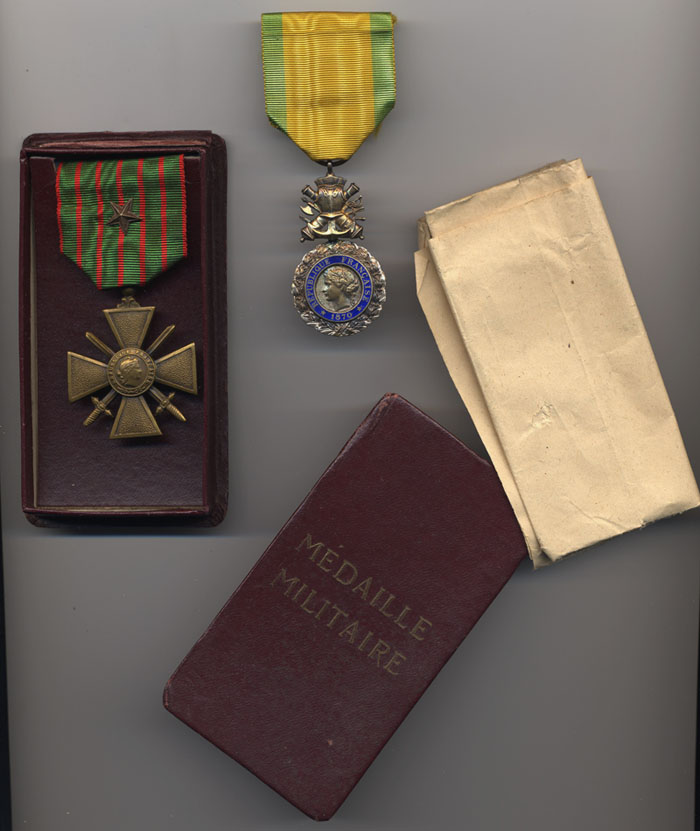
This group is in another thread here but it is relevant to the M?daille Militaire. This is a posthumous award, along with the Croix de Guerre, to an early casualty. I will scan the MM front and rear in due course as it seems to be a particularly nice example, possibly bought privately by the family at some point.
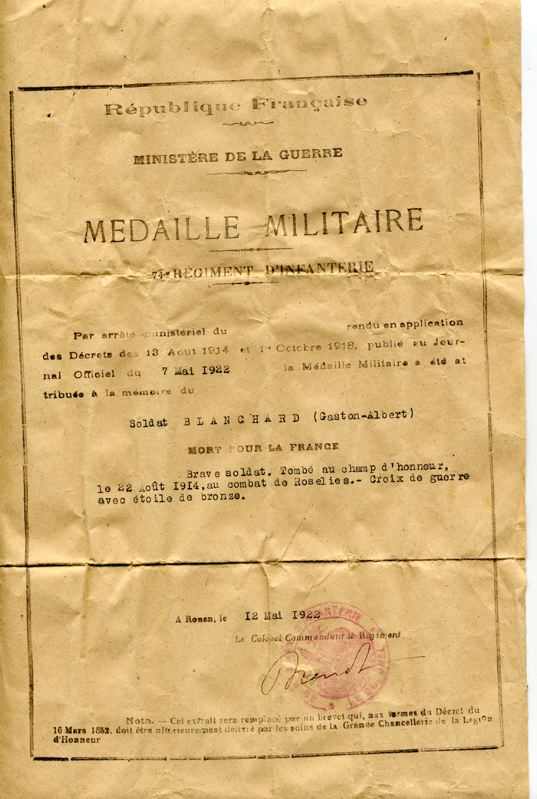
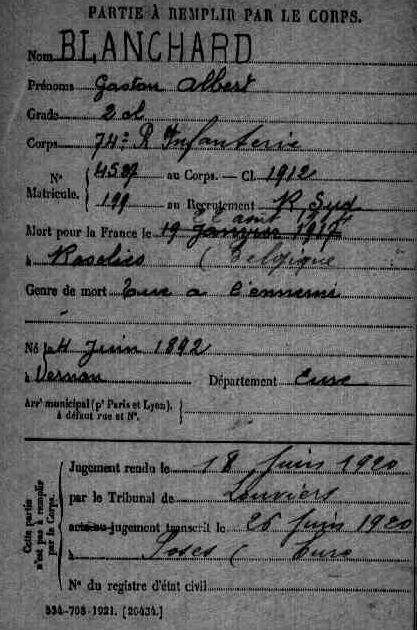
4,060 French soldiers died in street-fighting in the streets of the Belgian town of Roselies on 22.8.1914. It is actually known as The Battle of the Sambre. Most of the casualties were, like Gaston Blanchard, from the town of Rouen, serving in the 74th Infantry Regiment. Those of you familiar with my interest in the German Army's prewar Fallschirm-Infanterie-Kompanie/Bataillon, which assumed the traditions of the WW1 Sturm-Btl 7, may have seen references in my posts to the FIK's first barracks, the Roselies-Kaserne.
Anyway, living as we do in a world where the loss of, say, ten of our soldiers in some engagement in Iraq is treated with the same horror that greeted the casualty figures on the first day of the Battle of the Somme, for instance, just take a moment to think about 4,000-plus KIA in a day in a small town in Belgium just a week after the commencement of hostilities. It was a taste of things to come.
PK
0 -
Aahhh, magnifique! Et maintenant...les tr?sors sortent! Now the real jewels are starting to emerge. Here is a nice dipl?me to an artillery NCO.
 0
0 -
And now for something different... Some of you know this ensemble. It was previously discussed here: http://gmic.co.uk/index.php?showtopic=1650&hl=appleton
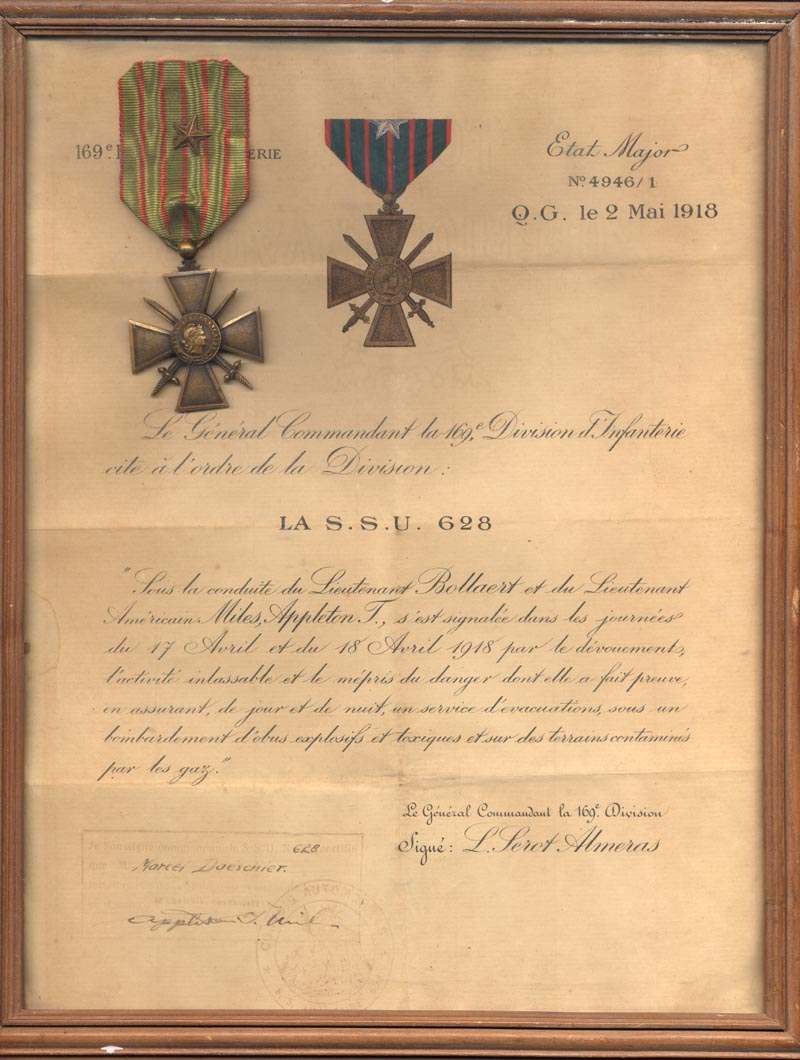 0
0 -
They are unusual! I have a CdG TOE somewhere with a similar type of Palm. Here is Gaston Blanchard's document and a copy of the official record confirming the manner of his death.

 0
0 -
A posthumous award to an early casualty, Gaston Blanchard, who was killed in action at the Battle of Rosalies.
 0
0 -
Unattributable because the houseclearer from whom I got it, with some other items, declined to give me any family names. I have the missing Palm with broken prongs.
PK
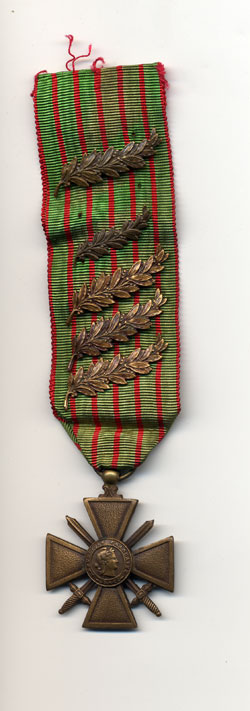 0
0




FRANCISQUE GALLIQUE
in France
Posted
All those names check out against the list compiled after the liberation. Mitterand is probably the most amazing recipient of all.
PK